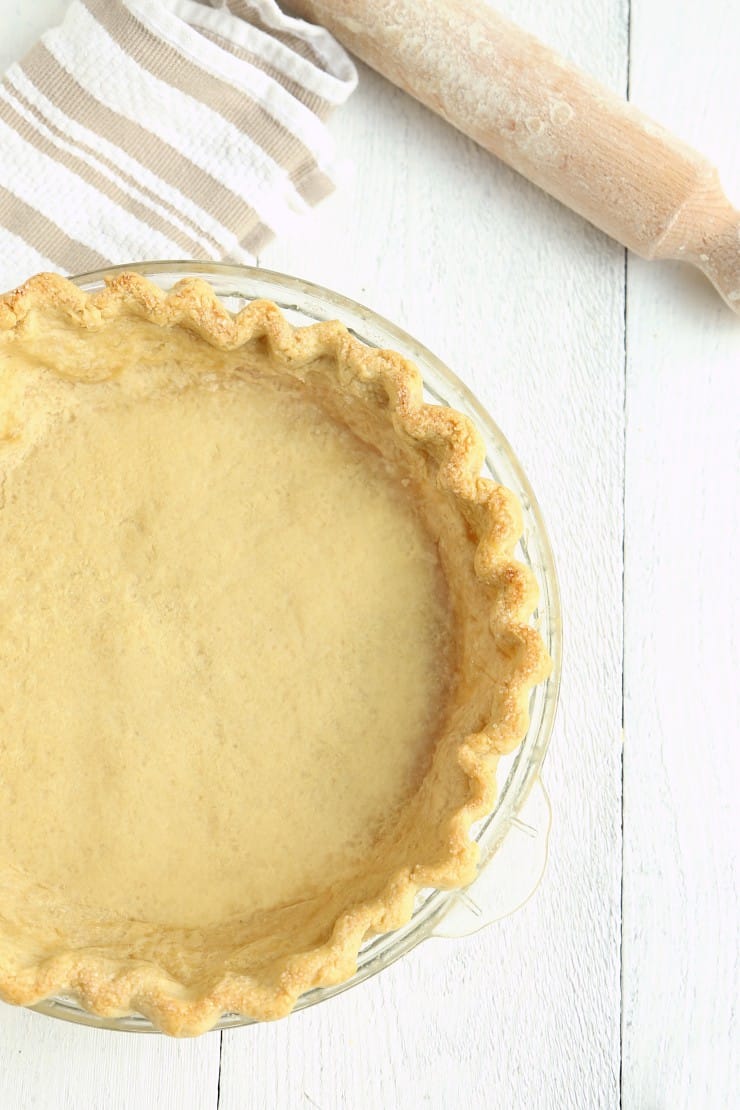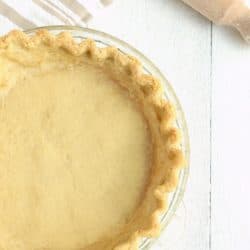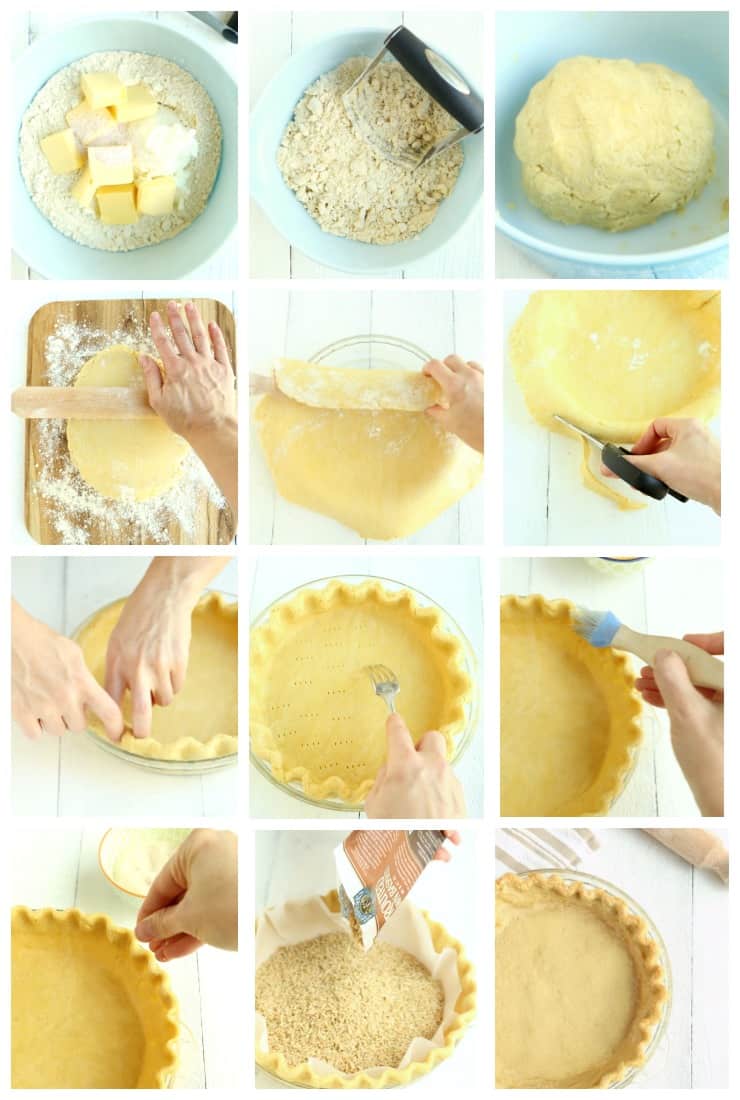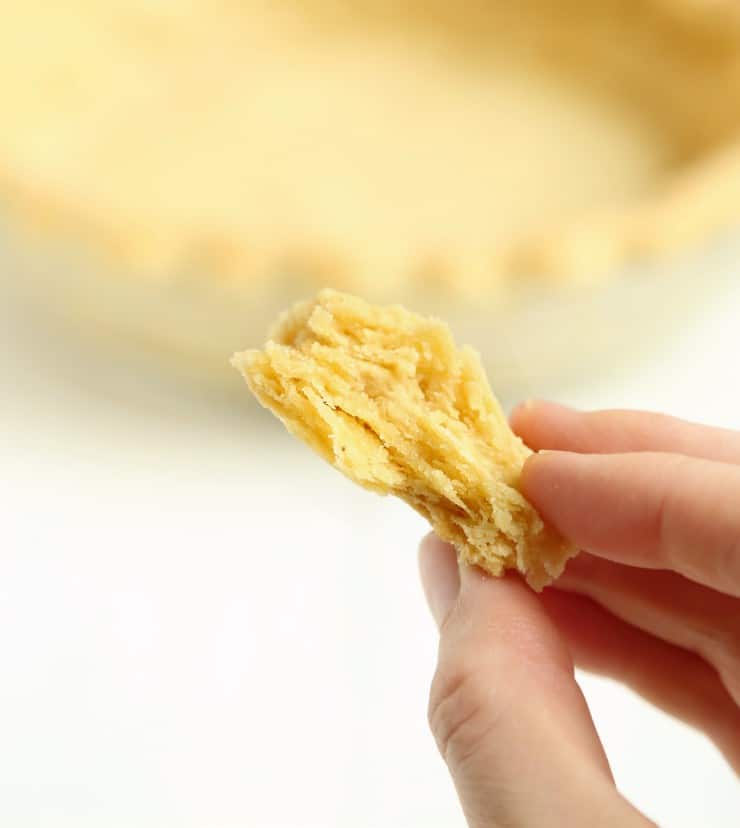This is the absolute best pie crust ever – it has a rich, buttery flavor with light and flaky layers and just a hint of sweetness that’s perfect for holidays and special occasions! Made ancient grain Einkorn flour, but can be adapted for regular white flour. Includes step by step tutorial with photos.

Nothing says holidays like a homemade pie with a homemade crust.
Pie crust has always been kind of a thing with me. If I’m going to have pie, I want to love the crust every bit as much as I love the filling. Know what I mean?
And there just isn’t a store bought crust around that can match the rich flavor and a flaky texture of homemade crust. Especially this homemade crust.
Best Flaky Pie Crust with Real Food Ingredients
Not only is this the best tasting and flakiest pie crust I’ve ever had, it’s also made with just a few simple, real food ingredients, so it’s healthier too! It’s made with ancient grain Einkorn flour and uses a blend of butter and palm shortening in place of the trans fat laden Crisco we all grew up using.
And it only takes 15 minutes to mix up and roll out!
How to Make the Best Flaky Pie Crust with Einkorn Flour
Mix dry ingredients, then cut in the butter and palm shortening. Add the egg and mix thoroughly, forming a ball. Knead the dough ball in the bowl or on a floured surface for about a minute until it’s smooth. Roll out, then transfer to a 9″ pie dish.
Trim the edges with kitchen shears, then use clean fingers to crimp the edges. Make sure the edges of the crust extend above the rim of the pie dish and rest on the rim just slightly to prevent the crust from sagging down as it bakes.
Brush with egg wash, then sprinkle with sugar. Depending on whether your pie filling needs to be baked in the pie shell, you can either add your filling and then bake or blind bake. If blind baking, either prick with a fork or line the crust with parchment and adding dried beans or rice to prevent it from puffing up, or do both!
Tips for Making the Best Flaky Pie Crust with Einkorn flour
- This recipe makes a single crust – just double everything if you’re making a double crusted pie.
- If you don’t have Einkorn flour, you can substitute any all purpose flour – just be aware you may need to adjust the flour/water content a little to get the right texture.
- I don’t refrigerate my dough before rolling it out because I just don’t find it necessary, but feel free to add that step if you prefer.
- The key to getting those beautiful fluted edges that stand up nicely is to be sure they’re a good bit higher than the rim of the pie dish and to press the dough back just slightly as you crimp it. This way, the fluted portion rests on top of the rim of the dish like a little shelf to prevent it from sagging down below the rim as it bakes.
- Brushing with egg wash and sprinkling with sugar is optional, but I love the sweet touch it adds!
- If you’re blind baking, prevent the bottom surface from puffing up when it bakes by either: (1) pricking the crust with a fork; or (2) lining with parchment and dried rice or beans. I prefer the parchment + dried beans/rice method.
- If you’re blind baking the crust, yes – you can still cook the dried beans or rice afterward – just return them to their bag and cook according to package directions when you’re ready!
- This dough freezes well – just follow the instructions to the ball stage, freeze. When you’re ready, bring it to room temperature and follow the remaining steps.
- This recipe makes great pastry for other recipes like this turkey pot pie or these beef and potato hand pies.
Just look at those layers…if that’s not the best flaky pie crust ever, I don’t know what is! 🙂

Best Flaky Pie Crust (with Einkorn Flour)
Ingredients
Pie crust:
- 3 cups Einkorn flour (can sub regular white flour, just adjust the amounts of water and flour a bit as needed to form the dough)
- 1 tsp sea salt
- 1 tsp aluminum free baking powder
- 1/2 cup pastured butter (I use salted)
- 1/2 cup palm shortening
- 1/3 cup ice cold water
- 1 large egg
Optional egg wash:
- 1 egg
- Coarse sugar for sprinkling
Instructions
- Mix flour, salt, and baking powder together in a mixing bowl. Add shortening and butter and cut in with a pastry cutter until it resembles coarse crumbs. Stir in the water and egg until well incorporated.
- Turn dough out on a floured surface and knead for at least a minute, until it forms a very smooth ball. Use a floured rolling pin to roll out the dough to a circle with 1/4" thickness. It works best to roll a little in all directions, then quickly lift the dough a couple inches off the floured surface, sprinkle some extra flour underneath if needed, and do a quarter turn before laying the dough down again and rolling some more. Repeat this as you roll so you turn it at least 3-4 times - This keeps the bottom of the dough from sticking to your surface. Once you're done rolling, the circle will be larger than you need, but it's always better to have extra crust than not not enough!
- Once the dough is the right thickness, gently roll the rolling pin from one end of the dough to the other so the dough is wrapped around the pin and can easily be transferred to a 9" pie dish. Starting at one end of the dish, carefully unroll the dough until it lays over all sides of the dish.
- Use kitchen scissors to trim the dough, leaving at least 1/2" over the rim of the pie dish.
- Use fingers to crimp the edges of the crust all the way around the pie as pictured above. Make sure the crimped edges extend up past the rim of the dish and lean back just slightly over the rim so it prevents the crust from sagging down too much as it bakes.
- Use a fork to prick the crust to allow steam to escape during cooking.
- For the egg wash: Use a fork or whisk to beat the egg gently, then use a pastry brush to brush evenly over the crimped edges of the crust (for an extra golden crust, use only the egg yolk). I like to sprinkle with coarse sugar before baking - it's optional but adds a nice touch of sweetness to the finished pie!
- Depending on what your pie recipe calls for, can either add the filling and bake or blind bake the crust first by lining it with parchment paper and filling it with dried beans or rice (pictured above) to keep the bottom surface from puffing up while it bakes. To blind bake, place the crust in a 425 degree oven for 10 minutes, or until the edges just begin to brown.
Notes
- This recipe makes a generous sized single crust - just double everything if you're making a double crusted pie.
- If you don't have Einkorn flour, you can substitute any all purpose flour - just be aware you may need to adjust the flour/water content a little to get the right texture.
- I don't refrigerate my dough before rolling it out because I just don't find it necessary, but feel free to add that step if you prefer.
- The key to getting those beautiful fluted edges that stand up nicely is to be sure they're a good bit higher than the rim of the pie dish and to press the dough back just slightly as you crimp it. This way, the fluted portion rests on top of the rim of the dish like a little shelf to prevent it from sagging down below the rim as it bakes.
- Brushing with egg wash and sprinkling with sugar is optional, but I love the little bit of sheen and the sweet touch it adds! For an extra golden crust, use only the yolk, not the whole egg.
- If you're blind baking, prevent the bottom surface from puffing up when it bakes by either: (1) pricking the crust with a fork; or (2) lining with parchment and dried rice or beans. I prefer the parchment + dried beans/rice method.
- If you're blind baking the crust, yes - you can still cook the dried beans or rice afterward - just return them to their bag and cook according to package directions when you're ready!
- This dough freezes well - just follow the instructions to the ball stage, then wrap well and freeze. Defrost in the fridge for several hours or overnight and follow the remaining steps.
- This recipe makes great pastry for other recipes like this turkey pot pie or these beef and potato hand pies.



Excellent crust! I used 2 c AP Einkorn and 1 c whole wheat Einkorn, and subbed coconut oil for the palm oil. For me, it made enough for 2 crusts, so I wrapped one disk and put it in the freezer for later. Thank you!
Thanks for sharing the feedback and your 5 star review, Sandy!
I made your pie crust..I only had spelt and buckwheat flours so I used 2 cups of spelt and one of buckwheat and for oils I used 3/4 of a cup of butter and a few tblsp of coconut oil..I followed all the directions and the crust worked out great..very flaky and rich..I used my biggest glass pie plate and did a double crust with one recipe and still have a7t least one crust left over which I froze..
Thanks for your comment, Jackie. So glad it turned out well for you, and that you have extra crust for a later use!
I want to make this crust but 3 cups of flour for a single crust seems like a lot when compared to most crust recipes. Please explain why. Thanks.
Hi Kurt,
Good question. I always like to have more crust than I need so I know for sure it will nicely cover my pie pan with enough for fluting. I usually snip the excess off with a knife or kitchen shears, then cut into strips to make “pie crust cookies” by brushing on a little butter and sprinkling with cinnamon-sugar, so the extra crust never goes to waste! 🙂
Ours was a flop. All over the bottom of the oven. Been making pie crusts for a long time and this was a disaster. Not sure what went wrong.
Oh, goodness – I’m sorry to hear that Erica! If you want to give me more details I’d be happy to help troubleshoot.
My pie crust came out perfect!!! THANK YOU!
This recipe looks wonderful! I was wondering if there was a substitution for the palm oil shortening?
Hi Shannon,
I haven’t tested this recipe with any subs, so I can’t say for sure. Sorry!
I substituted coconut oil for the palm oil and it turned out great!
Good to know – thanks for sharing that, Lisa!
Using Einkorn flour, I made this with butter and coconut oil, then tried to do a blind bake for 10 minutes (without any paper and weights). When I checked it at 6 minutes, the sides had sunk down into a puddle of thick dough! I tried to pull the sides back up, then filled with my custard and baked. The whole pie was done in 20 minutes (was supposed to take 40!), and most surprisingly, the “crust” had flipped to the top and the custard was below! It was delicious, but the “crust” was more like a soft cookie than… Read more »
Hi Diane,
I’m sorry your substitutes didn’t work out. Coconut oil is notorious for spreading – the palm shortening is a much better fit for pastry and pie crust. And I definitely find that adding the parchment and something to weight it down help a lot during the blind bake!